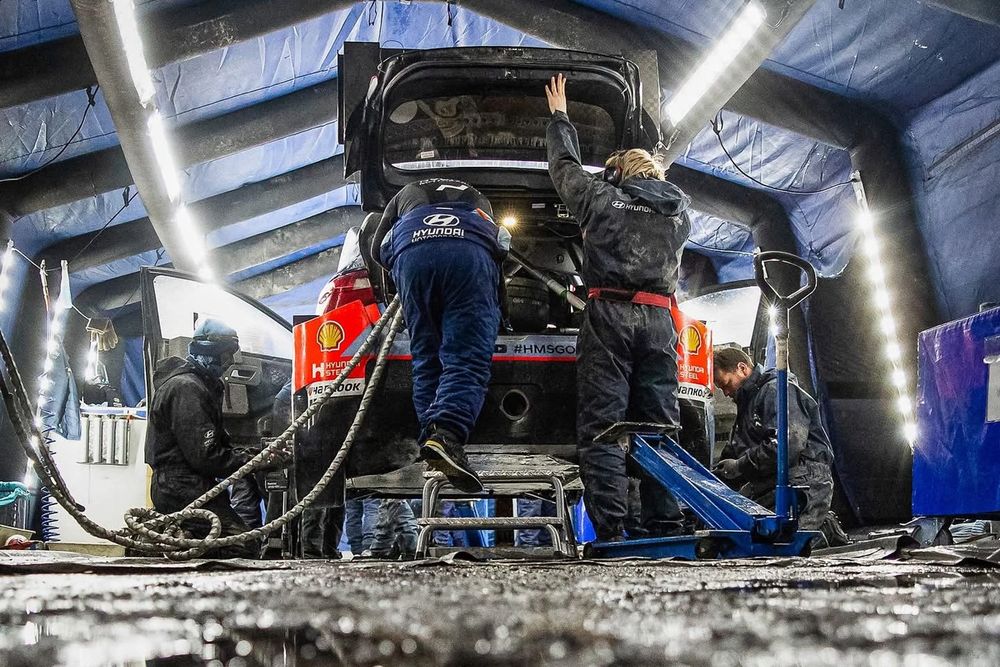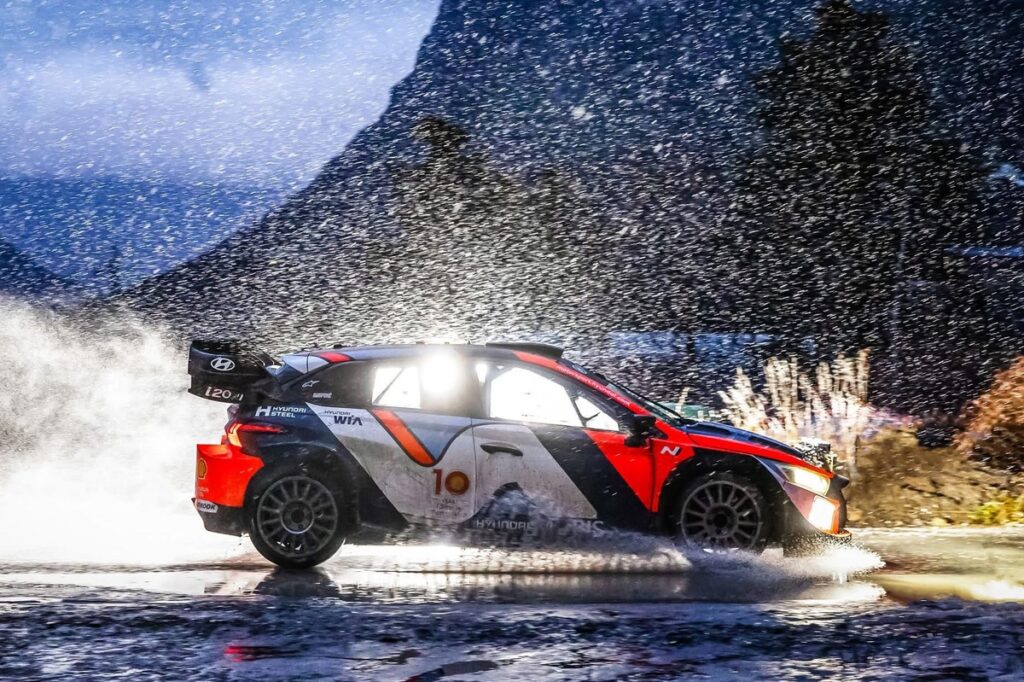New technical regulations and a change of tyre manufacturer has made preparations for the challenging Monte Carlo Rally among the most demanding for World Rally Championship teams in recent times. Not since the introduction of the Rally1 cars in 2022 has the WRC undergone such significant changes, heaping even more importance on teams to do the best job possible with their Monte pre-event tests.
The reason testing is even more crucial is because this year Rally1 cars will run without hybrid power, after the FIA decided to remove what was a key element of the original 2022 Rally1 package. This means cars have shed 87 kilograms and will run with a reduced 35mm air restrictor.
As a result, they will suffer a loss of 130 horsepower but will be much more agile without the extra weight. Teams now must quickly understand how their cars react in certain conditions, and in some cases exhaust systems, camshafts and gear ratios have been modified to adjust to the lack of hybrid boost.
But perhaps the biggest change for this season is the introduction of Hankook control tyres as the Korean company makes its debut in rallying’s top flight. Learning how the tyres perform on asphalt, gravel and snow has formed a large part of WRC team testing plans.
These changes prompted even the ‘Monte Master’, Toyota’s nine-time event winner Sebastien Ogier, to suggest that WRC crews will be “less prepared than ever”. It is a view shared by Hyundai’s test and development leader Jordi Riba.
“I have been in WRC for 10 years and this test is probably the most demanding because of the amount of changes,” Riba tells Autosport. We’ve made the trip to the south of France, 30 minutes from the Monte Carlo Rally’s host city Gap, to observe how teams prepare.
All WRC teams face significant changes heading into the 2025 season, putting greater emphasis on testing
Photo by: Hyundai Motorsport
“The car is the same, but the rules have changed a lot,” Riba adds. “The car is lighter, there is no hybrid and that could make our life easier, but we have change of tyre manufacturer which is an additional challenge.”
How does testing work in WRC?
Ogier’s comments stem from the fact that testing is extremely limited in the WRC. A mistake setting up the car in testing could therefore deliver dire results in the rally. Teams are allotted 21 days a year to conduct pre-event tests in Europe to prepare for rallies, and one extra event on the calendar this year means there will be even more pressure to execute test programmes successfully.
In addition to the testing allocation, teams are permitted unrestricted testing at their own permanent facilities. Toyota and Hyundai both have gravel bases in Finland, while M-Sport has access to gravel roads near its Cumbria factory. But it is the pre-event test day allocation that must be used wisely to ensure car set-ups are correct and drivers are comfortable for the conditions they will face at specific rallies.
The logistics involved are far more complicated than testing in circuit racing, where a team simply rents a permanent race track to pound round for lap after lap collecting data
Earlier this month, Hyundai descended on southern France to select test roads similar to the stages and conditions that crews will contests in the season opener. Drivers Thierry Neuville, Ott Tanak and Adrien Fourmaux completed one day each behind the wheel on different roads to gather vital information to prepare for the WRC’s annual curtain raiser.
On paper it seems simple, but in reality the logistics involved are far more complicated than testing in circuit racing, where a team simply rents a permanent race track to pound round for lap after lap collecting data. In rallying there are far more variables to consider.
Firstly, a public road that has similar aspects to the rally must be selected and then permission has to be sought from the local authorities to close the road. Marshals then have to be sourced, usually from the local motor club, to ensure the environment is safe for drivers to test and for those living in the area. So how does a team undertake such a task?
“As rallying is a confidence sport, we really need to work on the things that make a driver confident that they can go faster,” explains Riba. “In circuit racing they can do a lot of simulation, but in rally it depends a lot on conditions, so that can really change the way in that we work.

Plenty of behind-the-scenes work is involved even before set-up can begin due to the logistical challenges involved with closing roads for rally car testing
Photo by: Hyundai Motorsport
“We normally try to make our lives difficult by choosing roads that are more demanding than the real stages. We normally get a library of roads and depending on where we go, what we need, we then decide which road to pick. The final decision is with the driver to say where we go.
“We always need permission of the local Mayor [to close a road] because it will mean that the neighbours around the road will have some difficulties that day we test, so for sure we need to get a green light from the local authorities. But there are certain areas like here [near Gap] where they are used to teams coming to test for Monte Carlo, so they make it easy for us.”
Once roads are selected, a test plan is formulated in conjunction with the drivers back at the team headquarters in Alzenau to decide which items and settings will be tested. Once this is implemented, it’s time to hit the road.
Again, unlike circuit racing where teams work out of usually permanent pit garages, at the majority of rally tests the mechanics and engineers work out of tents pitched at the roadside. However, when occasion Autosport joined Hyundai it had fortunately commandeered a village workshop cut into the mountainside.
Test days usually begin from 8:30am and conclude at 6pm, with the designated road closed off to the public and marshalled throughout the period. Once the car is offloaded from the truck and mechanics complete an initial set-up, the driver will use the first two runs to learn the road before serious running can begin.
On this occasion the road was covered in snow and ice – an ideal opportunity to understand how the Hankook-shod i20 N Rally1 handles in the toughest of conditions synonymous with the Monte Carlo Rally.
“In the first couple of runs, the drivers get familiar with the road and the car, especially if the last time they drove it was on a different surface,” said Riba. “After that is when you can really start, but they are professional drivers so they get very quickly into the zone, so we can start testing items by run three.
“If the test goes well we can normally do over 200 kilometres per day, but of course it can also depend on how long the road is, and if something goes wrong or you need to make big changes on the car. You can lose up to 45 minutes.
“We try to not stop for lunch, but we organise for the drivers to have food when we do a longer stint. But sometimes the mechanics and engineers just grab some food while they are by the laptop, so we try to maximise our time.”
Fourmaux has already entered a rally for Hyundai in conditions similar to those he’ll face on the Monte
Photo by: Hyundai Motorsport
After a series of runs, the driver will return to the makeshift service park to allow the mechanics to undertake changes on the car as the team works through its test plan. Selecting the right rubber at the right time, in often changeable weather conditions, can decide the outcome in Monte Carlo. And since the tyres are new for everyone this year, acquiring as much data as to how each compound performs has never been more important.
“Testing is always important, but there was lot more to learn and discover,” reigning world champion Neuville tells Autosport. “Obviously on one test day, you can’t do everything. I had some targets which I basically achieved and from there we go and see what happens. But nobody can be perfectly prepared for Monte Carlo.
“Like usual, we did a lot of milage during the day because we had lots of tyre runs and tyre comparisons. Chassis-wise I felt quite comfortable in the car early on, because it is a car we know for a few years now.
“Monte Carlo is a big adventure and sometimes it is a mistake to think it is a sprint event. It is a four-day marathon” Jordi Riba
“[The Hankook tyre] is new, it is different. It is bit more edgy, that’s for sure, but we have been working on the tyres and we will continue working with the tyres around Monte Carlo. We have to work together with the tyre manufacturer to make the product even stronger.”
Is Hyundai ready for Monte Carlo?
According to Riba, three test days to adjust to Hankook’s tyres in preparation for Monte Carlo is “not enough”, but the team is satisfied with the information gathered by Neuville, Tanak and Fourmaux. The latter, signed from M-Sport, has already made his competition debut in a Hyundai, winning the 10-stage Rallye National Hivernal du Devoluy in December against opposition that included Toyota’s Kalle Rovanpera. It was also a useful first experience of the Hankook in live stages for the Frenchman, who has declared himself “quite comfortable”.
However, the work carried out in testing will be ultimately judged by the clock when the action begins in Monte Carlo next week.
“I’m not fully satisfied, but we did the best we could,” adds Riba. “Monte Carlo is a big adventure and sometimes it is a mistake to think it is a sprint event. It is a four-day marathon on ice and slippery conditions. I think we have managed to get the package [ready] but if it will be fast enough, we will see.
“For the test week we have tried to prepare as good as possible. But three days is not enough. In the rally we will see who has prepared the best.”
Will Hyundai’s diligent preparations yield rewards on the Monte?
Photo by: Hyundai Motorsport
In this article
Tom Howard
WRC
Thierry Neuville
Hyundai Motorsport
Be the first to know and subscribe for real-time news email updates on these topics
Subscribe to news alerts
Read the full article here

